Foreign Insulators
by Marilyn Albers
Reprinted from "Crown Jewels of the Wire", October 1995, page 8
This white porcelain claw top insulator belongs to Warren and Fay Forster of
Kurrajong, N. S.W., Australia, and was on display at the Marlborough National
last August. Perhaps you didn’t notice it on his table, since it’s not
exactly the Marilyn Monroe of insulatordom, but I promise you’ll respect it by
the time you get through reading this article. The insulator was produced in
1874 by Siemens Brothers & Co. Ltd., of London, England, as verified by the
green ink stamp on the skirt. Its base diameter is 3-3/8" and it stands 4-7/8" tall. In raised letters on the top of the iron hood are the words ‘SIEMENS
PATENT’. The insulator and pin are held together with cement, then mounted on
a 4" square base of iron. Lying on its side, you can see that it has an
inner skirt, or petticoat. Four bolts held the unit in place on the top of a
square pole.
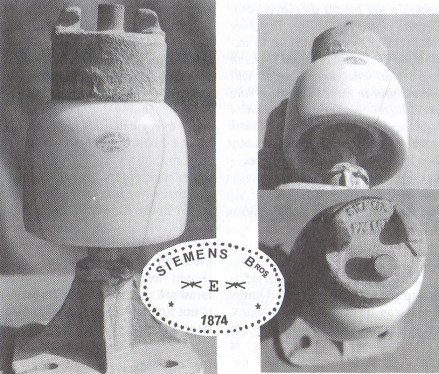
It is not unusual to find British porcelain insulators in Australia because
for many years this country has been (and still is) a member of the British
Commonwealth of Nations. Several English styles were imported for use there.
Many of them are considered rather common, but the SIEMENS is not common. It is
very rare and here is its story:
The insulator was used on the first East-West telegraph line joining Perth to
Adelaide. This line was badly needed because it was the last loop to be closed.
Sydney, Melbourne and Adelaide had been linked by telegraph in 1858, Melbourne
and Hobart (Tasmania) in 1859, Sydney and Brisbane in 1861, and Adelaide and
Darwin in 1872. Perth and Adelaide already had lines going part of the way,
Perth to Albany in the West and Adelaide to Port Augusta in the East, so in
August, 1875, construction of the East-West link began at the Port Augusta site,
and Albany followed in February, 1876. (See enclosed map.) Each state agreed to
be responsible for its portion of the line The route followed the coastline of
the Indian Ocean, right through the Nullarbor Plain, which was mostly scrub and
barren desert, with virtually no source of drinking water. South Australia
erected iron poles on their part of the line, but Western Australia chose to use
heavy square poles of jarrah wood (Eucalyptus), requiring at least 7000 of them.
These had to be towed by small sailing vessels from ports on the west coast of
Australia and delivered to several south coast ports. The ships would come in as
close as they could and unload the poles onto a barge. The barge was then pulled
to shore by a row boat and beached on the sand. Harnessed camels and horses were
enlisted to drag the poles to the construction sites. Each pole weighed over 100
kg! Once they were in place, one SIEMENS insulator was bolted onto the flat top
of each pole. In spite of many severe problems encountered by the workmen during
construction, each side of the line slowly built its way toward the center point
at Eucla, a small outpost right on the border between the two states and where
the two sections of the line would be joined together. After nearly two years,
the East-West link was finally completed in December, 1877.
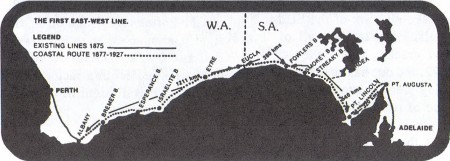
Because the line was so long (1,520 miles or 2,432 km), several telegraph
relay stations were positioned at intervals along the way. Telecom employees
lived at these sites, using Morse Code to send telegrams station to station. At
its peak, Eucla had a population of 50 people - 2 officers in charge, 24
operators, 2 linesmen, 2 storekeepers, a harbourmaster and women and children.
In 1904, electromechanical repeaters were installed and this hurt the prosperity
of Eucla. The staff and their families were drastically reduced from 50 people
to 5 men.
The first East-West telegraph line saw 50 years of useful service until it
was replaced by the transcontinental railway route in 1927. By this time modern
telegraph equipment had made the Eucla telegraph office old fashioned. With the
construction of the transcontinental railway, and telegraph lines alongside it
to the north, plus the increasing use of wireless telegraphy, the first line was
no longer needed and was closed. The town of Eucla was abandoned and eventually
became a ghost town with sand hills gradually covering the historic buildings.
The Forsters were able to retrieve only six of the SIEMENS insulators intact,
but all of them have cracks. A couple are dated 1872, and one has no marking at
all. Many were shattered beyond any hope of restoration. So how were they able
to find them at all? In 1993 they were insulator hunting on the Nullarbor Plains
near the beach, and that happened to be ‘the right place at the right time’.
There had been a severe sand storm in that area recently and enough tons of sand
had blown away to expose some of the insulators. They were still bolted to the
tops of the poles, which means the sand eventually became that deep from a long
series of these storms! Warren says that the cracks in the porcelain were caused
by the combined effects of salt water and the expansion of cement in the pin
holes. Let’s look at it this way - Grandparents’ wrinkles show that they
have led a long and useful life, and this brings respect. The same principle
could apply to these old insulators. They have been up on their poles doing
their jobs since 1877 and the cracks are their wrinkles! By the time Warren and
Fay recovered the six, they had been on that line for 116 years! How old are
your grandparents?
A HEAD SCRATCHER
The two glass insulators shown at the top of the following page are both CD
128’s, right? Wrong! (Well, you’re half right.) The Uruguayan piece on the
left is CD 128, but the Portuguese insulator on the right is enough taller to be
classified as CD 428. The difference in height is the deciding factor here. Just
in case you might have wondered!
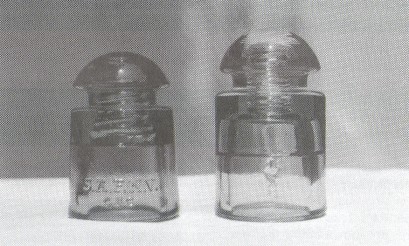
CD 128 from Uruguay and CD 428 from Portugal.
AND AN EYEBALL TWISTER
Having learned from the example above, these next two insulators must be
different CD’s, right? Wrong, again! They are both CD 510’s! (Are we
confused yet?) The reasoning behind this is that both insulators have basically
the same measurements, i.e. 1-5/8" base diameter and height of 2-3/8".
The slight differences between these two are in the slope of both the skirt and
the crown. N.R. Woodward thinks that the narrow crown version on the right was
probably the first style to be made and proved to be too fragile. He says “In
the embossed variety (on the left), it appears that the molds were machined out
on an angle to provide a stronger insulator and a better tying surface”. He
has no proof but it is the only thing that makes sense. Both examples were made
by CODARVI in Montevideo, Uruguay.
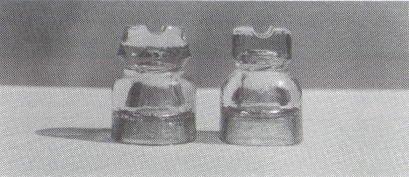
Both are a variation of CD 510 from Uruguay.
MORE INTERESTING SIGNS
The enameled metal sign shown below is from Poland. It came through
the door with Kevin Johnson at the recent National in Marlborough,
Massachusetts. The red lightning bolt, black letters and orange background
create quite a “color scream”! Definitely meant to get attention. It
measures 7-7/8" by 11-3/4". Translated loosely, the words are shown
below the sign.

(You are) NEAR (or in a)
(high) VOLTAGE (area)
The second sign is of a lighter weight metal and came all the way to the
National from Germany with Marco Schmitz-LeHanne. The border is black as are the
letters, the lightning bolts are bright red, and the background color is yellow.
Its measurements are 9-3/4" by 13-3/4" The words are translated below
the sign.
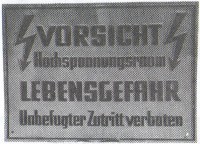
WARNING
HIGH VOLTAGE AREA
DANGER OF DEATH
NO TRESPASSING
|
